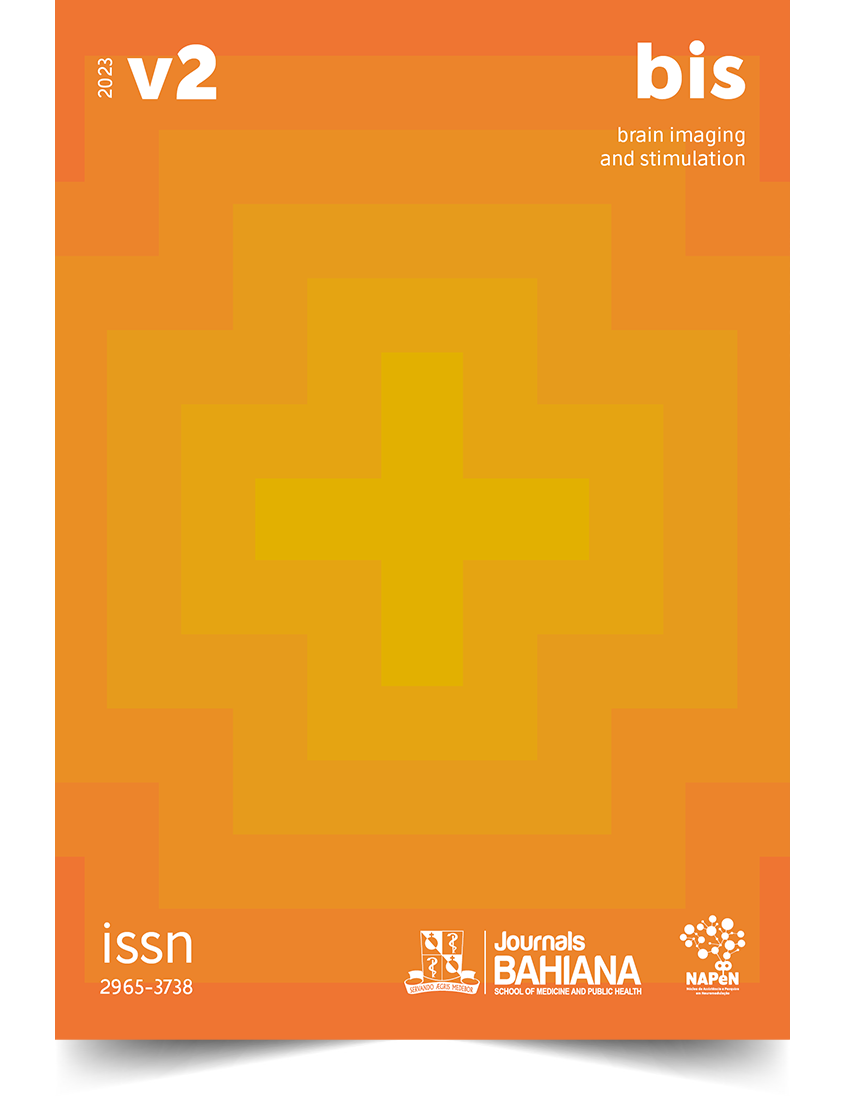Effects and parameters of taVNS in individuals with atrial fibrillation: an infographic
DOI:
https://doi.org/10.17267/2965-3738bis.2023.e4871Keywords:
taVNS, NIBS, Neuromodulation, Persistent Atrial FibrillationAbstract
INTRODUCTION: Transcutaneous auricular vagus nerve stimulation (taVNS) is a non-invasive neuromodulatory technique used to module autonomic excitability through the electrical stimulus of the vagus nerve. Studies have shown that taVNS can be used as a therapeutic strategy for arterial fibrillation (AF) management. This infographic aims to highlight the evidence about the effect and parameters of taVNS in individuals with AF. METHOD: We conducted a review using the PubMed mesh combination (Transcutaneous Electric Nerve Stimulation)AND(Nerve Stimulation, Vagal))OR(Nerve Stimulation, Vagus))OR(Nerve Stimulations, Vagal))AND(Atrial Fibrillation) that included six taVNS clinical trials with human adults over the age of 18. RESULTS: taVNS can promote an increase in the PQ interval on the electrocardiogram by increasing the parasympathetic tone. Moreover, the taVNS can prevent AF progression through antiarritmogenic effects, such as antiadrenergic mechanisms of neural remodeling, and a decrease of pro-inflammatory cytokines and AF of burden. DISCUSSION: The acute effect of taVNS can increase the P - wave alternans (PWA), which is believed to be related to AF. However, the chronic effect of taVNS for six months promotes a decrease in PWA and AF burden. In addition, the taVNS can alter the heart variability ratio parameters through the increase of the HF/LF relation in individuals with AF, which can be a signal of sympathovagal rebalance. However, the taVNS can improve the autonomic balance through the decrease in HF/LH relation in healthy individuals. CONCLUSION: The taVNS can be a useful therapeutic tool in the management of individuals with AF due to its antiarritmogenic effects.
Downloads
References
(1) Kharbanda RK, Does WFB, Staveten LN, Taverne YJHJ, Bogers AJJC, Groot NMS. Vagus Nerve Stimulation and Atrial Fibrillation: Revealing the Paradox. Neuromodulation. 2022;25(3):356-365. https://doi.org/10.1016/j.neurom.2022.01.008.
(2) Badran BW, Dowdle LT, Mithoefer OJ, LaBate NT, Coatsworth J, Brown JC, et al. Neurophysiologic Effects of Transcutaneous Auricular Vagus Nerve Stimulation (taVNS) via Electrical Stimulation of the Tragus: A Concurrent taVNS/fMRI Study and Review. Focus . 2022;20(1):80–9. https://doi.org/10.1176/appi.focus.20110
(3) Clancy JA, Mary DA, Witte KK, Greenwood JP, Deuchars SA, Deuchars J. Non-invasive vagus nerve stimulation in healthy humans reduces sympathetic nerve activity. Brain Stimul. 2014;7(6):871–7. https://doi.org/10.1016/j.brs.2014.07.031
(4) Peuker ET, Filler TJ. The nerve supply of the human auricle. Clin Anat. 2002;15(1):35–7. https://doi.org/10.1002/ca.1089
(5) Stavrakis S, Humphrey MB, Scherlag BJ, Hu Y, Jackman WM, Nakagawa H, et al. Low-level transcutaneous electrical vagus nerve stimulation suppresses atrial fibrillation. J Am Coll Cardiol. 2015;65(9):867–75. https://doi.org/10.1016/j.jacc.2014.12.026
(6) Stavrakis S, Stoner JA, Humphrey MB, Morris L, Filiberti A, Reynolds JC, et al. TREAT AF (Transcutaneous Electrical Vagus Nerve Stimulation to Suppress Atrial Fibrillation): A Randomized Clinical Trial. JACC Clin Electrophysiol. 2020;6(3):282–91. https://doi.org/10.1016/j.jacep.2019.11.008
(7) Chen M, Wang S, Li X, Yu L, Yang H, Liu Q, et al. Non-invasive Autonomic Neuromodulation Is Opening New Landscapes for Cardiovascular Diseases. Front Physiol. 2020;11:550578. https://doi.org/10.3389/fphys.2020.550578
(8) Dalgleish AS, Kania AM, Stauss HM, Jelen AZ. Occipitoatlantal decompression and noninvasive vagus nerve stimulation slow conduction velocity through the atrioventricular node in healthy participants. J Osteopath Med. 2021;121(4):349–59. https://doi.org/10.1515/jom-2020-0213
(9) Andreas M, Arzl P, Mitterbauer A, Ballarini NM, Kainz FM, Kocher A, et al. Electrical Stimulation of the Greater Auricular Nerve to Reduce Postoperative Atrial Fibrillation. Circ Arrhythm Electrophysiol. 2019;12(10):e007711. https://doi.org/10.1161/CIRCEP.119.007711
(10) Kulkarni K, Singh JP, Parks KA, Katritsis DG, Stavrakis S, Armoundas AA. Low-Level Tragus Stimulation Modulates Atrial Alternans and Fibrillation Burden in Patients With Paroxysmal Atrial Fibrillation. J Am Heart Assoc. 2021;10(12):e020865. https://doi.org/10.1161/JAHA.120.020865
(11) Stones C, Gent M. The 7 G.R.A.P.I.C Principles of Public Health Infographic Design. Leeds: University of Leeds; 2015.
Downloads
Published
Issue
Section
License
Copyright (c) 2023 Maria Williane de Sousa Ribeiro, Nicole Beatriz Nascimento Miranda, Fernanda Leite Dias Dantas Estevam, Tiago da Silva Lopes

This work is licensed under a Creative Commons Attribution 4.0 International License.
This work is licensed under a Creative Commons Attribution 4.0 International License.



